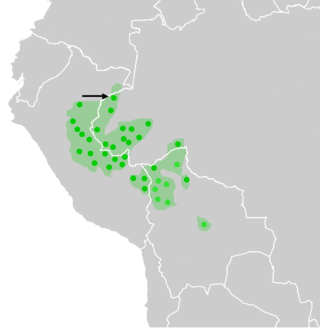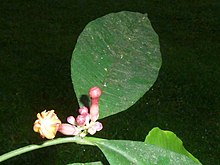
The Amazon rainforest, also called Amazon jungle or Amazonia, is a moist broadleaf tropical rainforest in the Amazon biome that covers most of the Amazon basin of South America. This basin encompasses 7,000,000 km2 (2,700,000 sq mi), of which 5,500,000 km2 (2,100,000 sq mi) are covered by the rainforest. This region includes territory belonging to nine nations and 3,344 formally acknowledged indigenous territories.

Apocynaceae is a family of flowering plants that includes trees, shrubs, herbs, stem succulents, and vines, commonly known as the dogbane family, because some taxa were used as dog poison. Members of the family are native to the European, Asian, African, Australian, and American tropics or subtropics, with some temperate members. The former family Asclepiadaceae is considered a subfamily of Apocynaceae and contains 348 genera. A list of Apocynaceae genera may be found here.

Tabernanthe iboga (iboga) is an evergreen rainforest shrub native to Central Africa. A member of the Apocynaceae family indigenous to Gabon, the Democratic Republic of Congo, and the Republic of Congo, it is cultivated across Central Africa for its medicinal and other effects.

The Amazon basin is the part of South America drained by the Amazon River and its tributaries. The Amazon drainage basin covers an area of about 7,000,000 km2 (2,700,000 sq mi), or about 35.5 percent of the South American continent. It is located in the countries of Bolivia, Brazil, Colombia, Ecuador, Guyana, Peru, Suriname, and Venezuela, as well as the territory of French Guiana.

The North Region of Brazil is the largest region of Brazil, corresponding to 45.27% of the national territory. It is the second-least-inhabited of the country, and contributes with a minor percentage in the national GDP and population. The area of the region is a little larger than India and a little smaller than the whole European Union. It comprises the states of Acre, Amapá, Amazonas, Pará, Rondônia, Roraima, and Tocantins.

Tabernaemontana is a genus of flowering plants in the family Apocynaceae. It has a pan-tropical distribution, found in Asia, Africa, Australia, North America, South America, and a wide assortment of oceanic islands. These plants are evergreen shrubs and small trees growing to 1–15 m tall. The leaves are opposite, 3–25 cm long, with milky sap; hence it is one of the diverse plant genera commonly called "milkwood". The flowers are fragrant, white, 1–5 cm in diameter.

Ibogaine is a naturally occurring psychoactive substance found in plants in the family Apocynaceae such as Tabernanthe iboga, Voacanga africana, and Tabernaemontana undulata. It is a psychedelic with dissociative properties.
Dan James Pantone is an American ecologist and conservationist with a Ph.D. from the University of California, Davis. A former professor at Texas A&M University, Dr. Pantone is a researcher who has published numerous refereed articles on agroecology and sustainable agriculture. In addition, he is a specialist in Geographical Information Systems (GIS) which he has used to help conserve endangered species. Dr. Pantone has established his broad experience in numerous scientific disciplines by publishing diverse articles ranging from the biological control of pests to the conservation biology of endangered species.

The Matsés or Mayoruna are an indigenous people of the Peruvian and Brazilian Amazon. Their traditional homelands are located between the Javari and Galvez rivers. The Matsés have long guarded their lands from other indigenous tribes and struggle with encroachment from illegal logging practices and poaching.

Matsés, also referred to as Mayoruna in Brazil, is an Indigenous language utilized by the inhabitants of the border regions of Brazil-Peru. A term that hailed from Quechua origin, Mayoruna translates in English to mayu = river; runa = people. Colonizers and missionaries during the 17th century, used this term, to make reference to the Indigenous peoples that occupied the lower Ucayali Region, Upper Solimões and Vale do Javari. Matsés communities are located along the Javari River basin of the Amazon, which draws out the boundaries between Brazil and Peru, hence the term river people. It is important to note that this term, was previously used by Jesuits to refer to inhabitants of that area, but is not formally a word in the Matsés language. The language is vigorous and is spoken by all age groups in the Matsés communities. In the Matsés communities several other Indigenous languages are also spoken by women who have been captured from neighboring tribes and some mixture of the languages occur. Dialects are Peruvian Matsés, Brazilian Matsés, and the extinct Paud Usunkid.

The Indigenous peoples of Peru, or Native Peruvians, comprise a large number of ethnic groups who inhabit territory in present-day Peru. Indigenous cultures developed here for thousands of years before the arrival of the Spanish in 1532.
Vale do Javari is one of the largest indigenous territories in Brazil, encompassing 85,444.82 km2 (32,990 mi2) – an area larger than Austria. It is named after the Javari River, the most important river of the region, which since 1851 has formed the border with Peru. It includes much of the Atalaia do Norte municipality as well as adjacent territories in the western section of Amazonas state. Besides the Javari it is transected by the Pardo, Quixito, Itaquai and Ituí rivers.
Alto Purús National Park is a national park in the Amazon rainforest of Peru, established in 2004. It covers an area of 2,510,694.41 ha (9,693.85 sq mi) in the provinces of Purús (Ucayali), Tahuamanu and Tambopata.

Jagua tattoo is a temporary form of skin decoration resulting from the application of an extract of the fruit Genipa americana, also known as jagua. This fruit has been used for body ornamentation and medicinal purposes in many areas of South America for centuries. It has recently been introduced in North America and Europe as an addition to henna body art, also called mehendi, mehandi, or mehndi in India.
Piers Gibbon is an English television and radio presenter, writer, and self-styled "adventurer".
Tabernaemontana palustris is a tropical flowering plant species in the family Apocynaceae. It grows in the Amazon Basin of northern South America. The species epithet palustris is Latin for "of the marsh" and indicates its common habitat.
Tabernaemontana sananho is a tropical tree species in the family Apocynaceae known as lobo sanango. Lobo sanango grows in the Amazon Basin of northern South America.
Acaté Amazon Conservation is a non-profit organization founded in 2012 by physician-ethnobotanist Christopher Herndon, M.D. and sustainable agriculturist William Park. Acaté Amazon Conservation works with the indigenous people of the Peruvian Amazon to help protect the Amazon rainforest while providing the indigenous people economic opportunities. Notable initiatives include permaculture methods for sustainable agriculture, generating income through renewable non-timber resources as well as preservation of traditional knowledge and culture.
The Matsés National Reserve is a protected area of Peru located in the Loreto Region, Peruvian Amazon. It has an area of 420,635.34 has..
The International Center for Ethnobotanical Education, Research, and Service (ICEERS) is a non-profit organization (NPO), headquartered in Barcelona. ICEERS is dedicated to transforming society's relationship with psychoactive plants by engaging with some of the fundamental issues resulting from the globalization of ayahuasca, iboga, and other ethnobotanicals. Founded in 2009, ICEERS is registered as a non-profit organization, and has charitable status in the Netherlands and Spain, and through partner organizations in the US and UK. ICEERS also has consultative status with the United Nations' ECOSOC.











